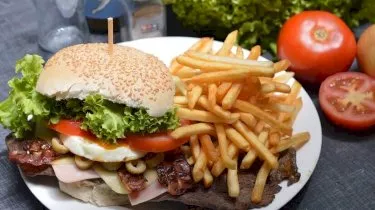Invest
Fast food assets a nutritious investment: real estate specialist
Some Australians believe fast food is part of a balanced diet, but according to Burgess Rawson, fast food property is also part of a balanced portfolio.
Fast food assets a nutritious investment: real estate specialist
Some Australians believe fast food is part of a balanced diet, but according to Burgess Rawson, fast food property is also part of a balanced portfolio.

Real estate agency specialising in commercial property, Burgess Rawson has sold 78 per cent of major drive thru free standing fast food assets in Australia in the last five years, and they argue the sector’s ability to embrace technology coupled with historical resilience makes it a compelling asset.
Speaking to mark the launch of Burgess Rawson’s Fast Food Property Investment Report this week, director Simon Staddon said: “These highly sought-after assets have a low risk profile with an upside and continue to grow in popularity, particularly with investors who own SMSFs. They offer long-term indexed income streams, underpinned by strong land values.
“Demand continues to increase for these tightly held ‘set and forget’ assets, with many landlords holding multiple properties. Investors are prepared to pay a premium to de-risk their property portfolios.”
From 2012 to 2017-18, fast food sales yields compressed from a median 7 per cent to 4.92 per cent, with investment prices sitting between less than $1 million to $9 million. Across their portfolio, assets have seen a capital gain of 64.9 per cent, or $1,252,000, between 2012 and 2017.

With 24 million Australians eating out twice a week on average, food is a “recession proof” asset, argued Neil Honan, managing partner of Honan Partners Chartered Accountants.
Statistics from the Australian Bureau of statistics back him up; at an average individual spend of $44 a week, eating out is Australians’ fourth-largest expense after rent, mortgage repayments and car loan repayments.
According to the report, demand for these assets is outweighing supply as brand recognition, compounded by land values, contributes to yield compression.
However, Mr Honan and Mr Staddon acknowledged that assets such as these can be “lumpy” for SMSFs attempting to fit them into a portfolio, given the price and value of the asset and the length of time it requires to be held.
With this in mind, Mr Honan noted that some investors choose to buy with a partner, or as part of a syndicate.
For example, three or four properties can be bought in a unit trust structure with four or five people putting $500,000 in each from their superannuation.
“What we’re seeing is that with a lot of wealthy clients, what they’re doing is using the super fund for overseas and domestic equities, term deposits, hybrids, real estate investment trusts and so on and then of course they're using their company or family trust structure to get 70 per cent debt, 30 per cent equity or in some cases 90 or 100 per cent equity and pay cash for those.
“They're not the typical investor but that's what they're doing. They’re putting the asset outside of super because it is such a lumpy asset and the price is so high.”

Property
New investment platform Arkus allows Australians to invest in property for just $1
In a groundbreaking move to democratise investment in property-backed mortgage funds, GPS Investment Fund Limited has launched Arkus™, a retail investment platform designed to make investing ...Read more

Property
Help to Buy goes live: What 40,000 new buyers mean for banks, builders and the bottom line
Australia’s Help to Buy has opened, lowering the deposit hurdle to 2 per cent and aiming to support up to 40,000 households over four years. That single policy lever will reverberate through mortgage ...Read more

Property
Australia’s mortgage knife‑fight: investors, first‑home buyers and the new rules of lender competition
The mortgage market is staying hot even as rate relief remains elusive, with investors and first‑home buyers chasing scarce stock and lenders fighting for share on price, speed and digital experienceRead more

Property
Breaking Australia’s three‑property ceiling: the finance‑first playbook for scalable portfolios
Most Australian investors don’t stall at three properties because they run out of ambition — they run out of borrowing capacity. The ceiling is a finance constraint disguised as an asset problem. The ...Read more

Property
Gen Z's secret weapon: Why their homebuying spree could flip Australia's housing market
A surprising share of younger Australians are preparing to buy despite affordability headwinds. One in three Gen Z Australians intend to purchase within a few years and 32 per cent say escaping rent ...Read more

Property
Tasmania’s pet-positive pivot: What landlords, BTR operators and insurers need to do now
Tasmania will soon require landlords to allow pets unless they can prove a valid reason to refuse. This is more than a tenancy tweak; it is a structural signal that the balance of power in rental ...Read more

Property
NSW underquoting crackdown: the compliance reset creating both cost and competitive edge
NSW is moving to sharply increase penalties for misleading price guides, including fines linked to agent commissions and maximum penalties up to $110,000. Behind the headlines sits a more ...Read more

Property
ANZ’s mortgage growth, profit slump: why volume without margin won’t pay the dividends
ANZ lifted home-lending volumes, yet profits fell under the weight of regulatory and restructuring costs—an object lesson in the futility of growth that doesn’t convert to margin and productivityRead more

Property
New investment platform Arkus allows Australians to invest in property for just $1
In a groundbreaking move to democratise investment in property-backed mortgage funds, GPS Investment Fund Limited has launched Arkus™, a retail investment platform designed to make investing ...Read more

Property
Help to Buy goes live: What 40,000 new buyers mean for banks, builders and the bottom line
Australia’s Help to Buy has opened, lowering the deposit hurdle to 2 per cent and aiming to support up to 40,000 households over four years. That single policy lever will reverberate through mortgage ...Read more

Property
Australia’s mortgage knife‑fight: investors, first‑home buyers and the new rules of lender competition
The mortgage market is staying hot even as rate relief remains elusive, with investors and first‑home buyers chasing scarce stock and lenders fighting for share on price, speed and digital experienceRead more

Property
Breaking Australia’s three‑property ceiling: the finance‑first playbook for scalable portfolios
Most Australian investors don’t stall at three properties because they run out of ambition — they run out of borrowing capacity. The ceiling is a finance constraint disguised as an asset problem. The ...Read more

Property
Gen Z's secret weapon: Why their homebuying spree could flip Australia's housing market
A surprising share of younger Australians are preparing to buy despite affordability headwinds. One in three Gen Z Australians intend to purchase within a few years and 32 per cent say escaping rent ...Read more

Property
Tasmania’s pet-positive pivot: What landlords, BTR operators and insurers need to do now
Tasmania will soon require landlords to allow pets unless they can prove a valid reason to refuse. This is more than a tenancy tweak; it is a structural signal that the balance of power in rental ...Read more

Property
NSW underquoting crackdown: the compliance reset creating both cost and competitive edge
NSW is moving to sharply increase penalties for misleading price guides, including fines linked to agent commissions and maximum penalties up to $110,000. Behind the headlines sits a more ...Read more

Property
ANZ’s mortgage growth, profit slump: why volume without margin won’t pay the dividends
ANZ lifted home-lending volumes, yet profits fell under the weight of regulatory and restructuring costs—an object lesson in the futility of growth that doesn’t convert to margin and productivityRead more








